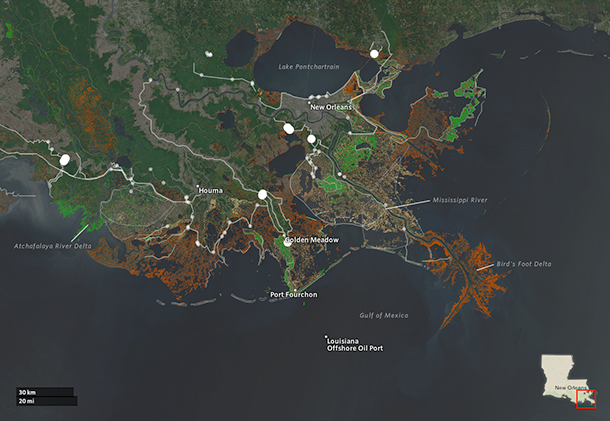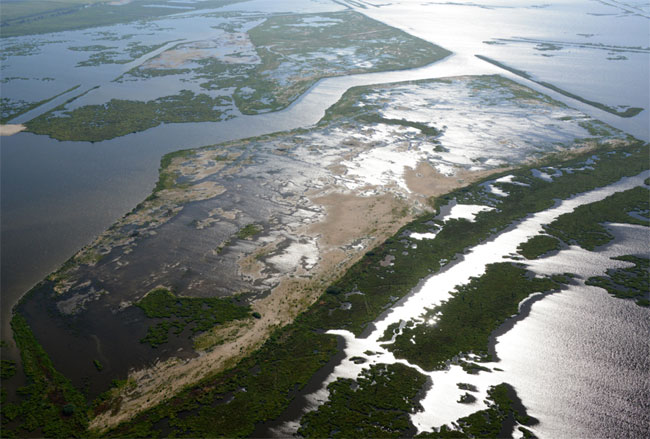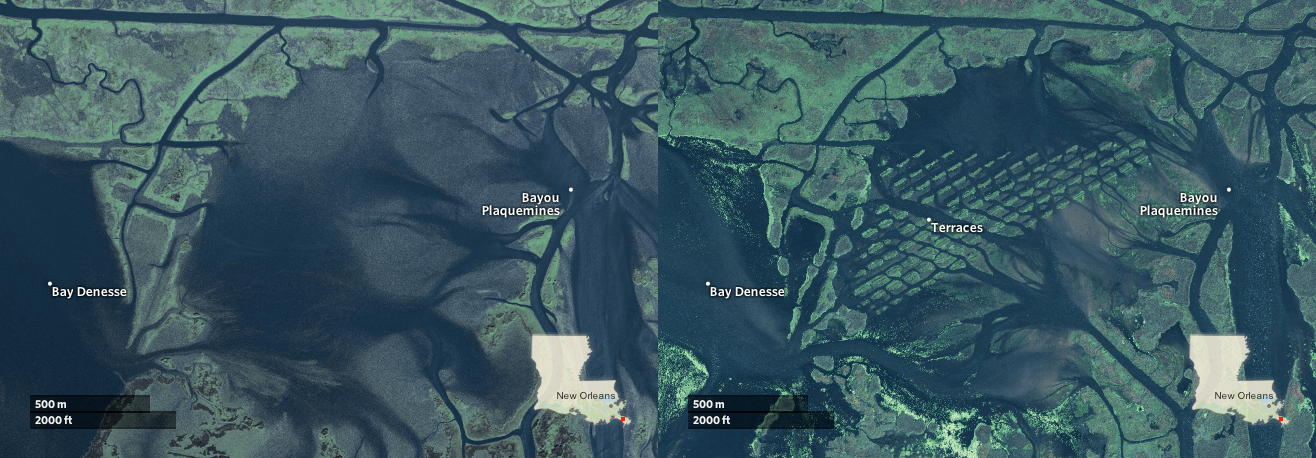Louisiana's Moon Shot
Air Date: Week of July 3, 2015

Louisiana’s Master Plan for the Coast includes projects like marsh creation, sediment diversion, levee, structural and shoreline protection, hydrologic restoration, and oyster reef restoration. The plan is ambitious and, if implemented on time, can restore and save some crucial wetland areas (in yellow and green), but some regions are sinking too quickly and will be sacrificed (in red). (Photo: Louisiana Coastal Protection and Restoration Authority, NASA/USGS)
The state of Louisiana is disappearing at the fastest rate in the world, and its sinking deltas threaten some of the nation's crucial oil, gas and fisheries industries. But Louisiana has a “Hail Mary” plan to save it. ProPublica reporter Bob Marshall speaks with host Steve Curwood about the state's ambitious and first-of-its-kind plan to preserve the region and what it might cost if they fail.
Transcript
CURWOOD: It's an encore edition of Living on Earth. I'm Steve Curwood. Louisiana is in trouble. The Mississippi River Delta is disappearing into the Gulf of Mexico at the rate of 16 square miles a year, some of the fastest land loss on the planet. These bayou lands are crucial to the nation's fisheries as well as regional oil and gas supplies and ironically, activity by the energy industry is helping to destroy its own infrastructure. As a response, industry and government have created an unprecedented plan to save and rebuild these wetlands over the next 50 years at an estimated cost of some 50 billion dollars. In a joint project with ProPublica, Bob Marshall, a reporter for the Lens, has co-authored an analysis of the plan called “Losing Ground”: Louisiana’s Moon Shot.
MARSHALL: What they're trying to do here has never been done before. They're trying to rebuild some of the wetlands that have been lost and then to maintain that against all these unknown variables such as subsidence and sea level rise and lack of funding. So in a very sense it is as ambitious in those two areas as going to the moon for the first time.
CURWOOD: So how do you rebuild wetlands? What are the methods that the engineering crowd is saying are possible to use?
MARSHALL: Well, the area was built by the river and that's the only chance to rebuild it is to get that settlement out of the river back into the sinking basins in this part of the state surrounding New Orleans. The problem is that there's only about half the sentiment of the river that it had when it built this area because of all the dams north of us. And the other problem is that the land is sinking at such a rapid rate, many of these areas are already too deep and too large to be rebuilt.

Lake Hermitage’s Marsh Creation project in September. (Photo: Louisiana Coastal Protection and Restoration Authority)
CURWOOD: What are some of the specific projects associated with this plan?
MARSHALL: Well, marsh creation is the states term for what I call slurry pipelines. They dredge sediment out of the river; pump it into some of the sinking basins and just re-create these areas as a once were. Going forward they hope to do this in areas of 33,000 acres, and the diversions basically re-creating or mimicking the way the river built these deltas originally is the heart of this project because they can build land as long as the river is running, so that's why they're key. They're also doing lots of shoreline stabilization and they're rebuilding oyster reefs to help protect the shorelines from wave action. There are also different types of projects with levies. Half of this $50 billion is going to be spent on structural protection for hurricane storm surge and the cost of that has risen dramatically because the core of engineers discovered during Katrina that its design parameters for building levees didn't work, so they had to increase them and that's the cost up. They're also doing research on how different plants will be impacted - you have to have the plants to hold the soils together - what will happen to the fish and the wildlife and there are lots of variables and other concerns that they have to take into consideration such as leaving enough water in the river for shipping, not displacing communities that might be flooded by these projects and trying to tend to the concerns of fisherman and the oil gas industry.
CURWOOD: Now, what kind of time does it take to do these things?

Photos of Bay Denesse from 2004 and 2014. State and Federal governments noticed that the wetlands surrounding New Orleans were not accumulating sediment because of the fast flowing waters. In 2006, they cut into the riverbanks in order to slow waterflow and eventually sediment deposited, building 98 berms. (Photo: USGS, Digital Globe)
MARSHALL: Well, this plan is a $50 billion, 50-year plan. According to the computer projections, if everything works according to plan and is implemented on time they could actually be gaining more land then they're losing in aggregate by 2060. The problem is, they only have $50 billion. This has never been done before. In several other projections out there are big concerns such as sea level rise.
CURWOOD: So where are these projects taking place? Where exactly?
MARSHALL: New Orleans is about 90 miles from the mouth of the Mississippi River and most of these projects will be taking place in the stretch of river about 50 to 60 miles from New Orleans. The last 30 or 40 miles of the river delta is just being given up because it's sinking at such a fast rate, in some places five feet a century so there's no hope of really saving those areas, so they're trying to rebuild these wetlands that are close enough to the city and its suburbs and the smaller communities out there to provide some type of storm surge buffer as well as have a functional fishery. This is the most productive coastal fishery outside of Alaska in North America and it's based on these wetlands.
CURWOOD: So, talk to me about some of the challenges that the planners and engineers expect in this project?
MARSHALL: Say locating the sediment diversion per se, first they have to find out how much settlement and the right types of sand and sediment that are going to be in the river at a certain location. And then of course can they get it to a basin that isn't already and deep and too wide to be treated. Then they have to figure out if it's in a stretch on the river or if they take water out of the river it won't cause shoaling to the south and disrupt shipping.

Louisiana’s Barataria Barrier Island Complex Project: Pelican Island and Pass La Mer to Chaland Pass Restoration (Photo: Coastal Wetlands Planning, Protection and Restoration Act; Flickr CC BY-NC-ND 2.0)
CURWOOD: So, Bob, who's going to pay for this?
MARSHALL: So far the state hasn't got much help from the federal government except in the form of rebuilding the levees that they didn't build properly around New Orleans, and it collapsed during Katrina. Congress back in 2007 authorized about 27 projects that are part of this master plan, but they haven't funded any of them, and of course they haven't shown any willingness. They're waiting to see how much money the state can gain from the Deepwater Horizon settlements from BP. The state recently said they could maybe realize as much as $4 or $5 billion. If they don't find other revenue sources they figure they'll probably run up against a financial wall in about 10 years. So right now they really don't know. They're hoping that Congress will look at this and say, you know, this is an investment worth making because it pays for itself and its economic benefits to the country.
CURWOOD: And what about the oil and gas companies that make a lot of money with the infrastructure that's there? To what extent are they investing in protecting, well, their own infrastructure?
MARSHALL: Well, they will tell you they pay in excise taxes both to the federal government and to the state government. Those haven't been raised in some time, and the state will be getting a larger share of the offshore royalties that go exclusively to the federal government and get a larger slice beginning in 2017 to the tune of about $175 million a year depending on gas prices, of course, that fluctuates wildly, but the oil and gas companies have contributed things like PR campaigns and some individual projects, but as far as tapping into that financial resource to help pay for this, the state's political body, they want the oil and gas companies to willingly come to the conclusion that it's in their self-interest.
CURWOOD: Some would criticize this effort by saying, wait; we spend a lot of money to protect private profits with public dough.

Congress approved 27 projects in Louisiana’s Master Plan, including marsh creation around Highway 1, which is important for the oil industry, and sediment and freshwater diversions from the Mississippi to rebuild wetlands, protecting New Orleans from storm surge. (Photo: Louisiana Coastal Protection and Restoration Authority, NASA/USGS)
MARSHALL: It is a problem for the state. Other the states look here and say why should we help you if you won't help yourselves? The state's congressional delegation is also among the most aggressive in opposing climate legislation, carbon legislation, of course, this is one of the most endangered, in fact, NOAA says it's the most endangered large coastal landscape sea level rise in the country. So other states the same way to manage you know you're like someone with long cancer who wants us to help pay for the chemo but doesn't want to quit smoking. But down the road if this isn't the number one issue for the politicians in the state, I think they'll be a tremendous crisis here. There will be a storm eventually that will flood a bunch of these communities, knock out refineries. They'll expose or break lots of these pipelines and then the nation will have to deal with that. That's pretty much historically the way the country deals with these same things. We kind of move forward by crisis rather than doing proactive things.
CURWOOD: Now, the fishing industry is also big in this region so what's their role in evaluating and modifying the master restoration project plans?
MARSHALL: Well, the wetlands here, the marsh, that is really the engine that drives fish reproduction here, but, of course, you need to rebuild what you are losing because once that base of habitat gets so small, production will fall off a cliff. Problem is that the people who make money from fishing here - shrimp, finfish, crabs, oysters - have been making their fortunes on a system that has been gradually turning more saline, saltier, so the people who some of the fisherman, they don't like the idea of these big diversions being open because it will turn the water in their bays much fresher and it will displace many of their target species and so they say, "I may have to go a lot further to catch fish or oysters or crabs or there might not be any." So they're looking for ways maybe of finding funding to mitigate the economic cost to some of these people if, in fact, they would be really hurt. No one's really sure if they would be that severely impacted.

Bob Marshall is a reporter for The Lens. (Photo: Courtesy of The Lens)
CURWOOD: So, do the math for me as a projected cost of $50 billion. We know that these things end up costing a lot more the end of the day, but what is the potential loss if this does not succeed or does not even start?
MARSHALL: Well, that's hard to say, I think. You know, 50 percent of nation's refining capacities along this coast, 30 percent of its total energy supply comes in pipelines from these 4,000 rigs offshore. They would have to start looking for ways to either relay these pipelines, move the refineries, and so as this turns to open water, they have to go somewhere. They have to be rebuilt or reengineered at enormous expense, so it's quite the crisis that's fast approaching. People always ask me are you optimistic this will get done? I'm optimistic it could be done, but I think the human element is much more...and the political element is much more of a variable that could kill the effort than overcoming the science and engineering part of it. But if they don't succeed here then about a million people have to find new places to live and one of the nations key energy corridors could be disrupted, if not shut down, and the port that serves 31 states would be in serious trouble. So, you know the old cliché failure is not an option, and the other thing here is that there's a deadline. If they don't get this done and 50 to 60 years they can't get it done and it will just be this massive environmental evacuation, immigration from this part of the state north finding homes for people and industries.
CURWOOD: Bob Marshall is a reporter for The Lens. Thank you so much.
MARSHALL: Thank you.
Links
Louisiana’s Comprehensive Master Plan for a Sustainable Coast
Our previous interview with Bob Marshall regarding Louisiana’s disappearing coasts
Living on Earth wants to hear from you!
Living on Earth
62 Calef Highway, Suite 212
Lee, NH 03861
Telephone: 617-287-4121
E-mail: comments@loe.org
Newsletter [Click here]
Donate to Living on Earth!
Living on Earth is an independent media program and relies entirely on contributions from listeners and institutions supporting public service. Please donate now to preserve an independent environmental voice.
NewsletterLiving on Earth offers a weekly delivery of the show's rundown to your mailbox. Sign up for our newsletter today!
 Sailors For The Sea: Be the change you want to sea.
Sailors For The Sea: Be the change you want to sea.
 The Grantham Foundation for the Protection of the Environment: Committed to protecting and improving the health of the global environment.
The Grantham Foundation for the Protection of the Environment: Committed to protecting and improving the health of the global environment.
 Contribute to Living on Earth and receive, as our gift to you, an archival print of one of Mark Seth Lender's extraordinary wildlife photographs. Follow the link to see Mark's current collection of photographs.
Contribute to Living on Earth and receive, as our gift to you, an archival print of one of Mark Seth Lender's extraordinary wildlife photographs. Follow the link to see Mark's current collection of photographs.
 Buy a signed copy of Mark Seth Lender's book Smeagull the Seagull & support Living on Earth
Buy a signed copy of Mark Seth Lender's book Smeagull the Seagull & support Living on Earth

